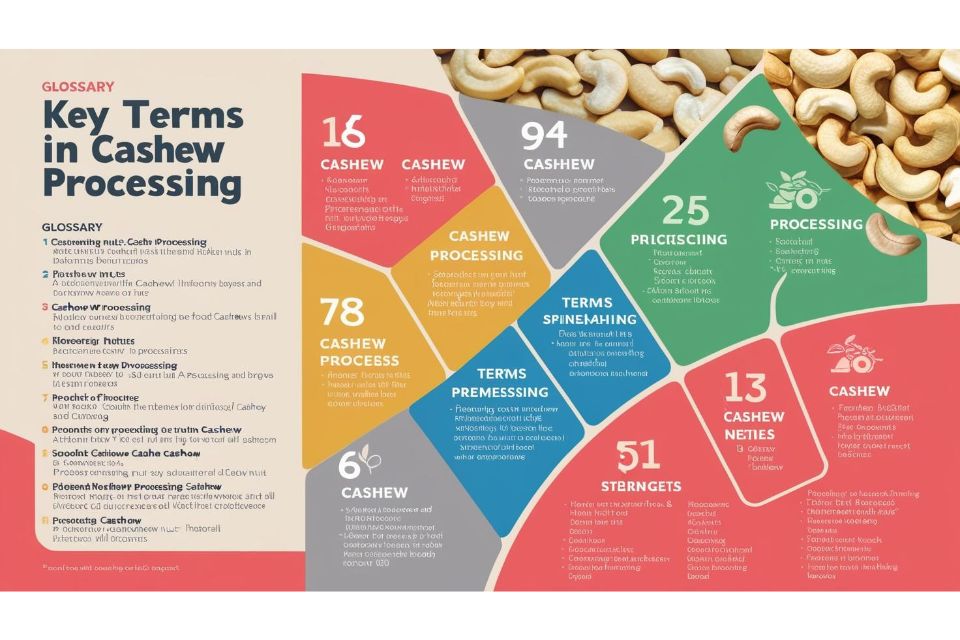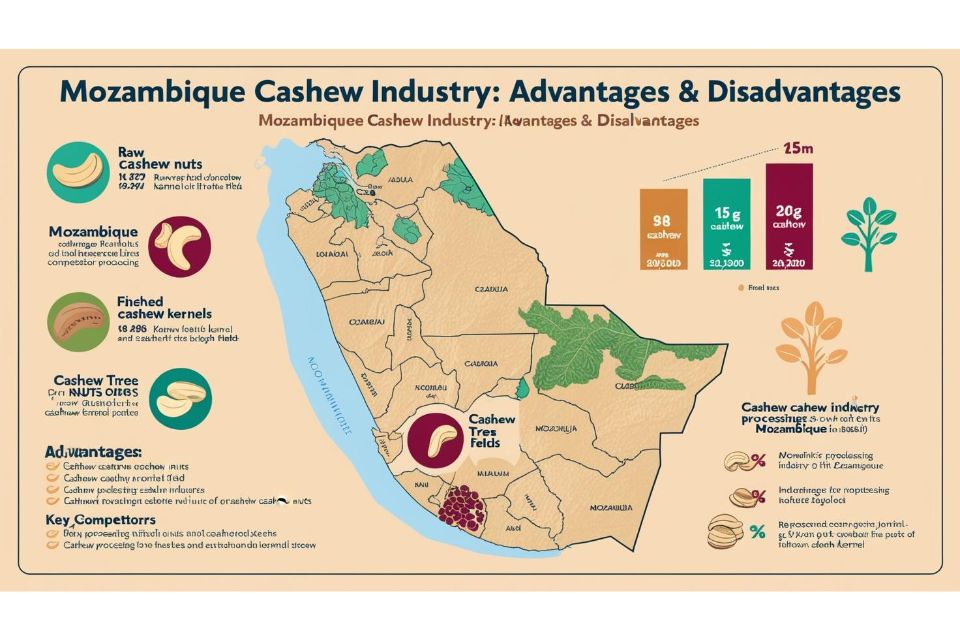Factors Influencing Cashew Processing Factory Size Selection
Several factors that influence the choice of processing scale when establishing a cashew processing factory.
Financial Resources
The scale of a cashew processing factory is determined by its annual processing capacity, which refers to the quantity of raw cashew nuts a factory can process each year. Financial resources are a primary determinant of processing scale. A larger processing scale, such as a large-scale factory that processes around 30,000 MT/year, requires significantly more investment in machinery, infrastructure, and labor compared to a small-scale factory processing less than 1,000 MT/year.
Location
The choice of location is interconnected with other factors, influencing the scale of the processing facility:
- Availability of Raw Materials : Proximity to raw cashew nut (RCN) suppliers is a key factor. A factory located closer to sources of RCN can potentially handle larger volumes of raw nuts and therefore justify a larger processing scale. Transportation costs and logistics are also more manageable with a factory situated near RCN production areas.
- Labor Considerations : The availability and cost of labor vary significantly across regions. Regions with a plentiful and affordable labor force might support a larger factory size, especially if the processing model relies heavily on manual labor. However, if labor costs are high, a smaller factory with a higher degree of mechanization could be more viable. Factors such as labor culture, skills, and productivity levels in the factory’s location are also important considerations.
- Access to Utilities : Reliable access to electricity, water, and communication infrastructure is crucial for the operation of any processing facility. A location with readily available and affordable utilities can support a larger-scale factory. Conversely, limitations in utility access might necessitate a smaller factory size to operate within those constraints.
- Satellite Processing Units: A larger processing facility may choose to establish smaller, localized processing units, known as satellite processing units, in outlying villages that produce RCN. These satellite units can focus on initial processing steps like shelling or peeling, and then transport the semi-processed nuts to the main factory for further processing and packaging. This strategy can help to secure access to raw materials, distribute employment opportunities, and potentially justify a larger central processing factory.
Raw Material Characteristics
The specific characteristics of the RCN being processed can also influence the choice of factory size:
- Kernel Outturn: The kernel outturn, or the percentage of usable kernel obtained from the raw nut, can vary between different varieties and batches of RCN. If the kernel outturn is high, a larger processing capacity might be chosen to maximize output from the available raw material.
- Nut Count and Size Distribution: The average nut count (number of nuts per unit weight) and the size distribution of the RCN can influence the choice of shelling and grading equipment, which in turn impacts the overall processing capacity and factory size.
- Ease of Peeling: The ease with which the testa (the thin outer skin) can be removed from the kernel can affect the efficiency of the peeling process. If the kernels are difficult to peel, a larger factory with more peeling capacity, either manual or mechanized, might be necessary to achieve the desired output.
- Shell Thickness and CNSL Content: The thickness of the cashew nut shell and the content of Cashew Nut Shell Liquid (CNSL) can influence the choice of shelling and heat treatment equipment. These choices, in turn, affect processing capacity and contribute to determining the appropriate factory size.
Machinery and Technology
The choice of machinery and level of mechanization are intertwined with factory size:
- Processing Scale and Mechanization: The cashew processing equipment market offers a wide range of machines suitable for different scales of production. Small-scale factories with limited capital may rely more heavily on manual processing methods and simpler, less expensive machinery, while medium to large-scale factories often invest in more sophisticated and automated processing lines to increase efficiency and handle larger volumes of RCN.
- Availability and Performance of Equipment: The availability of specific types of processing equipment, as well as their performance characteristics, can play a role in determining factory size. For example, advancements in high-capacity shelling machines with continuous flow, low breakage rates, and improved shell/kernel separation have made larger-scale processing more feasible.
- Technological Advancements and Innovation: As noted in the sources, the cashew processing equipment market is constantly evolving, with ongoing innovations in peeling and shelling technologies, as well as the emergence of new suppliers from various countries [16, 20, 23]. These developments can influence the choice of factory size by creating new possibilities for efficiency, automation, and processing capacity.
Management and Expertise
The availability of skilled management and technical expertise is essential for the success of any processing facility, and it can also influence the scale of the operation:
- Technical Knowledge and Skills: A larger, more mechanized factory requires a higher level of technical expertise to operate and maintain complex processing equipment. The availability of skilled technicians, engineers, and maintenance personnel in the region can therefore influence the feasibility of establishing a large-scale factory.
- Management Experience and Capacity: Effective management is essential for coordinating the various stages of cashew processing, ensuring quality control, managing labor, and handling logistics. The availability of experienced managers with a strong understanding of the cashew processing industry is crucial, especially for larger-scale operations.
- Training and Capacity Building: Investing in training programs for factory staff is crucial for maintaining operational efficiency and product quality. Larger factories may require more comprehensive training programs to ensure that workers are proficient in operating and maintaining specialized equipment, following food safety protocols, and meeting quality standards.
Market Demand and Customer Requirements
The target market for the processed cashew kernels and the specific requirements of customers can influence the choice of factory size:
- Volume and Consistency of Supply: Large-scale buyers, such as international retailers or food processing companies, often require a consistent supply of high-quality kernels in large volumes. A larger factory with a higher processing capacity is better positioned to meet these demands.
- Quality Standards and Certifications: Meeting stringent quality standards, such as those set by the Association of Food Industries (AFI) [27], or obtaining certifications like organic or fair trade, can enhance market access and potentially justify a larger processing scale to capitalize on those market segments.
- Packaging and Labeling Demands: Customer preferences for specific packaging formats or labeling requirements can influence the choice of packaging equipment and the overall factory size needed to accommodate those processes.
Other Considerations
- Working Capital: Access to sufficient working capital is crucial for purchasing raw materials, covering operational expenses, and managing cash flow, especially during the cashew harvesting season. A larger processing scale generally requires more working capital to support the increased volume of operations.
- Government Policies and Regulations: Government policies, such as those related to export incentives, import duties, or environmental regulations, can affect the feasibility and profitability of cashew processing. Favorable policies can encourage investment in the industry and potentially support larger-scale processing.
- Business Climate and Market Information: The overall business environment, including factors such as political stability, access to financing, and the availability of reliable market information, can influence investment decisions and the scale of processing operations.
- Sustainability Goals: A processor’s commitment to sustainability can also factor into the choice of factory size. A smaller-scale factory with a focus on local sourcing, waste reduction, or community development might align with a processor’s sustainability goals.
The choice of factory size is a complex decision with significant implications for the success and profitability of a cashew processing business. Carefully considering these factors in the planning stages is essential for making an informed decision that aligns with the processor’s resources, market opportunities, and long-term vision.


